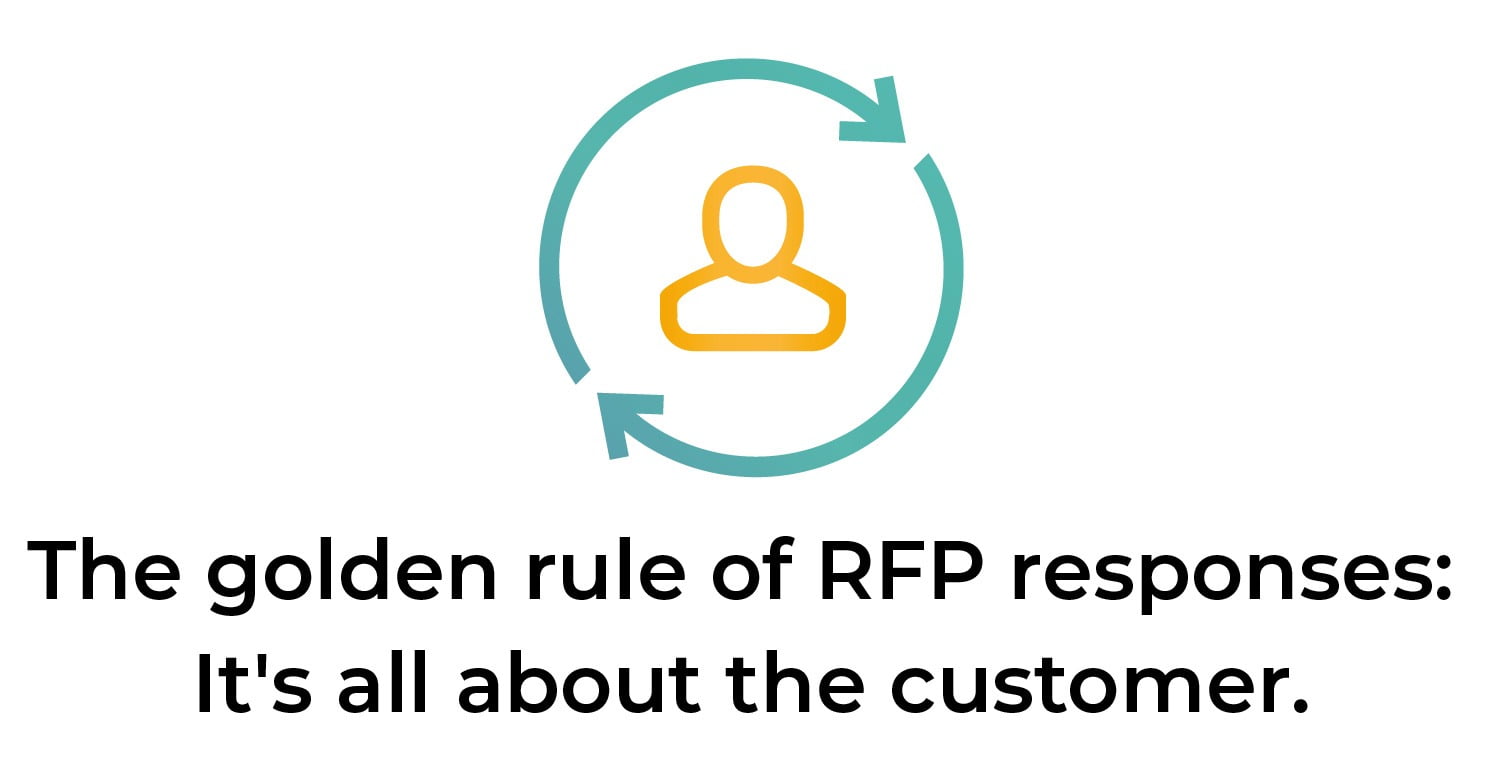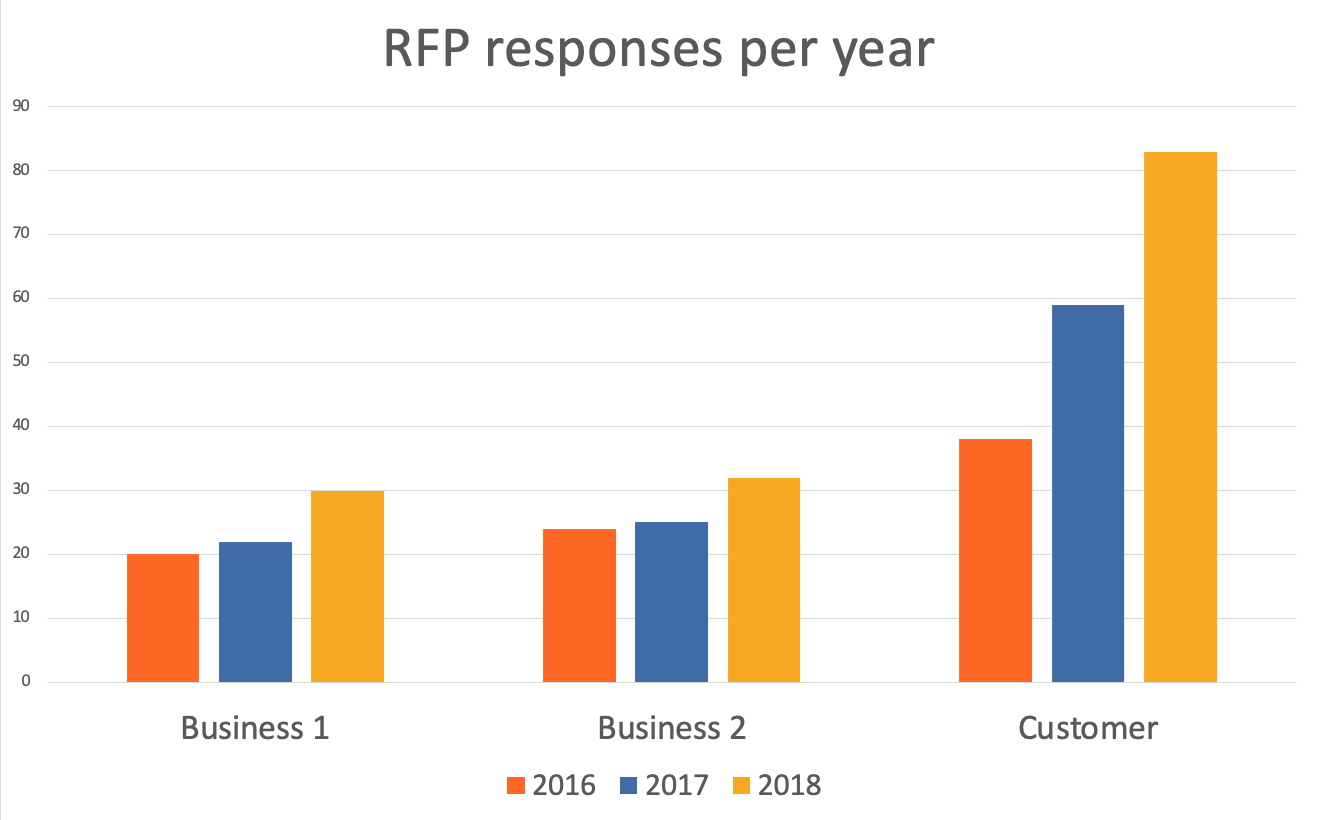RFP360 is a part of RFPIO, the leading response management software. To explore additional resources about how to write a winning RFP response, visit RFPIO.com.
There’s nothing more frustrating than spending hours writing, editing and collaborating with SMEs only to find out you lost another RFP opportunity. Your business puts hours into each proposal. So, if your hard work isn’t paying off as often as it should, it may be a good time to explore what goes into a winning RFP response.
Behind every winning RFP response is a proposal team. And as they can tell you, creating compelling and engaging proposals is a learned skill. Not only does it take time and practice, it also requires a bit of trial and error.
In this blog, I’ll break down an RFP response, section by section, to define the goals of each and explore how to accomplish them. Then, I’ll offer RFP response best practices as well as winning examples. Finally, I’ll conclude by exploring common challenges that come up during the RFP response process and how to overcome them.
- Section-by-section guide to creating a winning RFP response
- Proposal content best practices
- Common RFP response roadblocks and how to overcome them
Section-by-section guide to creating a winning RFP response
Before we get into the nitty-gritty details of each section, let’s start with the golden rule of request for proposal responses: It’s all about the customer. In each section and in every response, keep the customer in mind. Remember, these incredibly busy people have a problem to solve. Therefore, if they feel like you’re wasting their time, you’ve already lost them. So, as we work through each RFP response section, remember these guidelines:
- Stay focused on the customer’s problem and the solution you deliver
- Keep it short and fluff free — for the customer, the RFP isn’t an invitation for you to give a sales pitch, it’s a fact-finding mission
- Stick to the project scope and remove any information that isn’t immediately relevant, save the upsell for later

RFP response sections: Goals and how-to guide
RFP cover letter
The goal: Make a good first impression, create a human connection and let the customer know you truly understand their problem.
How to do it: Share your enthusiasm about the prospect of being a part of their future success. Then, restate their known objectives. Finally, paint a picture of how your solution solves their problem and makes their job easier. Make it all about them.
If you’re ready to write a killer cover letter, download this RFP cover letter template.
Executive summary
The goal: Give a high-level overview, summarize the most important parts of your proposal and prove you’re qualified to meet their needs.
How to do it: Research. Do your homework to ensure your executive summary addresses the customer’s biggest concerns. Find out why they’re issuing the RFP. Did their last provider fail to deliver? Is their business growing? The more you can speak directly to their needs, the greater your chance of winning the project. Remember, your summary needs to provide enough information to stand alone if it’s the only piece of the proposal an executive sees. However, it also must be short enough to read in a couple minutes.
Want to see what a stand-out executive summary looks like? Check out this executive summary template example for a guide.
Project implementation plan and schedule
The goal: Help the buyer picture themselves as your customer and prepare them for the next steps in the buying process.
How to do it: Be specific. Your project implementation plan and schedule sets expectations. For example, establish milestones and address any concerns the customer expressed. In addition, provide a full project plan outline from purchase to go-live date. Use the RFP timeline the buyer provided and set milestones assuming a start date almost immediately after the RFP’s final selection announcement.
It is also helpful to share key contacts and staff the customer will work with from subject matter experts to project managers. Finally, include what you’ll need from their business to ensure a successful engagement. For example, current process documentation, training timelines, user roles, administrator input and so on.
Contract management
The goal: Ensure a speedy contracting process that benefits both you and the customer.
How to do it: In this section of your request for proposal response, get your ducks in a row so the contracting process goes smoothly. For example, share what you’ll need to execute the contract and include who will be involved. Then, outline the approval process and required documentation. Consider preemptively providing your standard SIG assessment or security questionnaire as well as terms and conditions.
In addition, offer an overview of how you’ll continue to support the customer after the contract is executed. Include information about their customer success manager, any available self-service tools and who will supervise the delivery of contract terms.
If possible, provide very specific details — how often will someone check in, what will be covered and how feedback is addressed? Remember, it’s all about them. Make them feel confident that you’re in it for the long haul and prepared to be a true partner to them.
Customer references and case studies
The goal: Provide concrete evidence of the results they can expect.
How to do it: Share the positive return on investment you’ve achieved for customers similar to your prospect. Of course, don’t make them just take your word for it. Also include metrics and powerful quotes provided by happy customers. If possible, offer to connect them with a current customer for a reference call. Certainly, there’s nothing more persuasive than hearing candid feedback from a peer.
Explore everything you need to know about return on investment in this ebook: Measuring the value of RFP software.
Proposal content best practices with winning RFP response examples
Beyond hitting the goals for each RFP section outlined above, winning RFPs have great content. I’ve reviewed content from countless winning RFP response examples and they all have a few things in common. I’ve collected these themes and created a list of RFP response best practices and examples below.
Insert the customer into your answers
Remember, it’s never about you. Your audience doesn’t care how great you are. They only care about how you can make their lives easier and improve their profitability. All of your answers should support your argument that you will make them more efficient, effective and empowered.
In addition, don’t just explain what you do, but also why it’s important. This focus will help you write an about us and background statement that will make prospects pay attention.
Original RFP response:
Our company improves efficiency and cost savings.
Winning RFP response example:
XYZ solution, empowers ABC company to optimize efficiency and maximize savings.
Keep it simple and skimmable
Your evaluators are pressed for time. Write clearly and succinctly. Use headings, subheadings, call-outs, and bullets to make your proposal easy to skim. And, remember to keep it simple so your responses can be read and understood by anyone.
Original RFP response:
With XYZ solution, which optimizes internal and external collaboration and communication processes, automates RFP management, improves workflow and empowers reporting, our current customers like ABC Company are able to not only respond to complicated RFPs, but also issue requests, security questionnaires and due diligence questionnaires for a full-circle procurement and proposal experience.
Winning RFP response example:
Customers like ABC Company leverage XYZ solution to:
-
- Improve internal and external collaboration
- Automate complex RFPs
- View workflows and reports
- Issue RFPs and questionnaires
- Centralize procurement and proposal functions
Include visualizations
Charts and graphs quickly convey a more powerful message than a spreadsheet full of data. Use visualizations to help customers understand your impact.
Original RFP response:
XYZ solution’s customer submitted 83 proposals in 2018. More than twice the number completed by their competitors.

Winning RFP response example:
XYZ solution’s customer submitted 83 proposals in 2018. More than twice the number completed by their competitors.

Review, revise then review again
Typos, style inconsistencies and abrupt changes in grammatical tense or tone can be incredibly distracting for your reader. Consequently, it’s important to review your responses and make sure they all work together and sound consistent.
In fact, try reading your responses out loud. It will help you catch a ton of errors or awkwardness that spell check won’t. A recent blog from Proposal Reflections offers five things to watch for (and remove) from your proposals including: long sentences, passive voice, empty words, nominalizations and incorrect words. Follow these guidelines to make your content stronger, more concise and more persuasive. The post also offers this example:
Original RFP response:
Our COTS solution saves the Government time and money.
Winning RFP response example:
Our COTS solution provides the Government with life-cycle savings of $250,000 in software development costs.
Common RFP response roadblocks and how to overcome them
The customer isn’t asking the right questions.
The challenge:
The customer missed something key in their RFP. Whether the gap in information makes it difficult for you to win or might also result in the customer selecting an incomplete solution, it’s worth mentioning. But how do you make sure the customer has all the information they need?
Work through the roadblock:
Procurement professionals are skilled at finding the best vendor for a project. However, they may not be an expert in the nuance of your particular industry, good or service. So, they likely used stakeholder requirements and feedback to customize an existing RFP template. Unfortunately, that process often leaves gaps in knowledge and results in an incomplete RFP. It also puts you in a tough position of trying to explain additional value you deliver that the customer doesn’t understand and didn’t ask about.
Typically, at the beginning of the RFP timeline, there’s a period to allow for vendor questions. This is a good time to raise the concern. Simply include it in your questions. For example, you can ask: “Have you considered unaddressed factor, is that an area of need for ABC Company? Alternatively, you could say, “Many of our customers ask about unaddressed factor, would you like us to include information about how XYZ solution solves this challenge?
Time consuming back-and-forth with subject matter experts (SMEs)
The challenge:
One of the hardest parts of creating a request for proposal response is coordinating with your subject matter experts. They’re usually very busy people. And, while they’re experts in their field, they likely all have a different writing style. So, how do you make RFP responses from a dozen different sources look consistent and sound cohesive?
Work through the roadblock:
Most SMEs are just as excited about winning new business as you are, but they can’t read your mind. Unfortunately, they won’t know intuitively what to cover just by reading the RFP question. So, be clear about what you need. SMEs are usually happy to provide answers that cover customer hot buttons, written in the company’s preferred proposal format — they just need to know what that is. It’s usually as simple as providing your SMEs with a company style guide for faster editing.
In addition, make sure you’re searching your knowledge library before asking an SME to weigh in on an RFP question. There’s nothing more frustrating and alienating than answering the same question over and over again. If you find an applicable knowledge record, send the response to the SME for review. After all, updating or customizing a response is a lot faster than writing from scratch. Certainly, this is a situation where RFP software that centralizes internal collaboration is an advantage.
SMEs are a key part of your proposal team. So, bring them into the fold and make the importance of their role clear. Include SMEs in proposal kickoff meetings, regular content updates and annual process reviews. Even if they can’t make every meeting, putting in the effort to keep them involved will help them feel invested.
The RFP clearly favors a specific vendor
The challenge:
You recognize your competitor’s language in the RFP. It seems like they are the incumbent vendor or are heavily favored. You suspect their capture management team helped craft the RFP. To have a fighting chance, you’ll need to overcome an unfair preference with education and awareness.
Work through the roadblock:
Some RFPs aren’t fair. That’s the unfortunate truth. We all know our competitors and for the most part, we’re all using the same tactics to try to win new business. For example, we all know how much easier it is to write a winning RFP response when your team helped craft the RFP itself.
If you notice the RFP favors a specific approach or if phrasing is overly specific, that’s a good indication of a competitor’s influence. Use your competitive intelligence to counteract their preconceived notions. Without naming the competitor, explain why your product or approach better addresses their needs.
Alternatively, just ask. Reach out to the RFP contact and look for more background information. Is there an incumbent vendor? If so, why has the project gone back out to RFP? What would sway the decision maker or what is the competitor lacking that would make the decision easy? Ultimately, addressing the lack of transparency head-on will help you make a well-informed decision to bid or not to bid.
The RFP response has a quick turnaround
The challenge:
In the world of RFPs, time is typically your biggest adversary. Your proposal timeline can only be compressed so much and manual processes make submitting responses on time difficult.
Work through the roadblock:
One of the best ways to fast-track your proposal process is to invest in RFP response software. Not only will it automate your responses by suggesting answers to previously asked questions, but it will also empower you to:
- Search and find past proposal content
- See who wrote the content and when it was written
- Review the revision history
- Verify when the content was last reviewed and updated
- Check how often it’s been used
Too many teams spend all their time writing answers but never organize them. If your team can’t find and reuse past RFP responses, collaborate on content and easily see team responsibilities and next steps, you’ll end up constantly reinventing the wheel.
Ultimately, everyone involved in the sales and proposal process is working toward a singular goal — to win new business. And, for proposal professionals, there is no greater feeling than hearing that your team submitted a winning RFP response. Follow these winning RFP response best practices to see all of your writing, editing, collaborating and waiting pay off.



